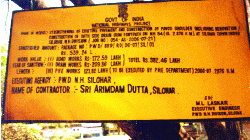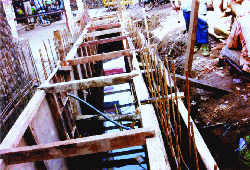Archives
WHITHER SILCHAR ROADS AND DRAINAGE ?
21 kms of immediate covered drains (Rs. 30,56,9000), 122 kms of feeder drains on both sides of roads and streets along with slab culverts and pipe culverts for quick disposal of storm water from the residential area (Rs. 59,8,51,000) and twelve number of pumps and a few sluice – gates for evacuating water from different critical points as well as strengthening of ring bund and excavation of Malini Beel as detention basis.
Even after more than two years of the work being taken up, citizens are wary about the shape of things to come. Questions have been raised: Is the drainage system being executed properly? Haphazard method of implementation has created more problems. Residents of Malugram, Shillong – Patty, Rangikhari, Bilpar and Tarapur in particular are skeptic if the ongoing footpath cum drainage work flushes out excess water during rains and channelize it to outlets. The narrowing down of the new drains, they also allege, will obstruct the operation of excavator to clean the accumulated garbage. The biggest residential area of the town Malugram remains waterlogged for two months during rains due to the locked sluice gates. The expanded Link Road residents in the east face water logging problem every year. Where is the outlet? Faced with mounting public critism, NBCC Additional Deputy Manager, Raj Nath Singh at a press meet, clarified, “Their work could not make headway due to the lack of cooperation of the district administration.” Encroachments all along the alignment have made their job tough. There is no scope of widening the drainage, he pointed out. He also said the work would be carried out in six phases and completed by 2016. Till then, the hard pressed people of this town will have to put up with water logging. On outlets, it was said, “Presently the priority is on inlets, not outlets.”
Faced with mounting public critism, NBCC Additional Deputy Manager, Raj Nath Singh at a press meet, clarified, “Their work could not make headway due to the lack of cooperation of the district administration.” Encroachments all along the alignment have made their job tough. There is no scope of widening the drainage, he pointed out. He also said the work would be carried out in six phases and completed by 2016. Till then, the hard pressed people of this town will have to put up with water logging. On outlets, it was said, “Presently the priority is on inlets, not outlets.”
Many chinks have come out of this multi crore drainage cum footpath project. No satellite survey was done. Detailed project report and its specifications remain shrouded. There is no coordinator among PWD(R), PHE Dept., BSNL, ASEB, Municipal Board, Town and Country Planning wing and Silchar Development Authority. Result: there is no speed or direction in thework. Fed up with interference of this syndicate, two engineers of NBCC resigned and left. The worst casualty of all this is the quality of work.
Bithika Dev, Chairperson of Silchar Municipal Board, at a discussion on the problem at Silchar Press Club, while sharing citizens’ anxiety expressed her displeasure at their ‘negative attitude’. She blamed the mushrooming hotels and residential complexes for not having their own proper internal drainage system. She favoured developing satellite township to ease much of the civic problems.
It is the same confusing scenario in respect of the repair and improvement of roads of this town, 80% of which are in shambles. The agencies contracted by PWD(R) N.H Division – NBCC and Alliance Project Implementations – constructing the road from Capital travels point to Holy Cross School a stretch of 3.5 kms at an estimated cost of Rs. 5 crore have no specific time frame to pull the town out of the quagmire of dusty, stony and potholed roads. The Deputy Commissioner of Cachar, Gautam Ganguli, fixed June 15 as the deadline to complete the construction. The contractors remain unmoved and in the process with the onset of the monsoons, the vehicle users, commuters and pedestrians have to put up with the worst ordeal. After dust comes mud. It is really amazing that Silchar roads should remain in bad shape despite liberal flow of funds from the centre.
According to a survey of 1997 conducted by an NGO, the roads and footpaths of the town have to bear the burden of around 1 lakh people on an average every day, most of who come from rural areas on various work. The town with municipal area of 15.71 sq. kms and a population of 5 lakh is plagued with traffic snarl, congested and narrow roads, choked drains, ever increasing encroachments and above all, fragrant violation of rules on the ground. If drain cum footpath is being constructed in a wayward manner, roads in the same manner are being rebuilt without proper specifications.
S.R. Swami, former Chief Engineer of PWD(R), found lack of mission and vision on the part of NBCC and Alliance Project Implementations (API). Partha Ranjan Chakravorty, Chairman of Silchar Development Authority, asked with cynicism, “Why are roads not being built scientifically despite there being no dearth of funds?” Tax payers are not clear about works on roads and drainage cum footpath specifically allotted to NBCC and API. PWD(R) N.H. Division has put up a signboard near Holy Cross School, giving details of works to be implemented by Arindam Dutta of API but no such details have been made public about NBCC. All this raises intriguing questions about planning and implementation.
Considering the plight of citizens, The Institution of Engineers at a public meet on the civic issues agreed to constitute a 5 member experts’ committee to study critically the detailed project report of NBCC. When contacted by the Chairman of IOE Kalyan Kumar Dutta, an official of the Corporation said, “The DPR is in Delhi.” The signal is clear. There is neither transparency nor accountability, nor is there any public voice.

